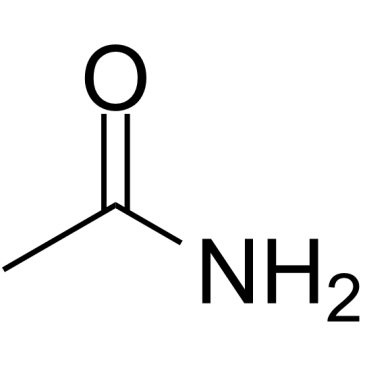Acetamide

Acetamide structure
|
Common Name | Acetamide | ||
|---|---|---|---|---|
| CAS Number | 60-35-5 | Molecular Weight | 59.067 | |
| Density | 1.0±0.1 g/cm3 | Boiling Point | 78.4±23.0 °C at 760 mmHg | |
| Molecular Formula | C2H5NO | Melting Point | 78-80 °C(lit.) | |
| MSDS | Chinese USA | Flash Point | 1.2±22.6 °C | |
| Symbol |

GHS08 |
Signal Word | Warning | |
|
Polymorphisms in the ITS rDNA regions for differentiating strains of the Trichophyton mentagrophytes complex in Sfax-Tunisia.
Mycoses 57(8) , 453-9, (2014) The Trichophyton mentagrophytes complex is the main cause of superficial mycoses in humans and animals. Molecular research has provided useful insights into the taxonomy of this complex to overcome the challenges with conventional diagnostics. The aim of this... |
|
|
Cheminformatics analysis of assertions mined from literature that describe drug-induced liver injury in different species.
Chem. Res. Toxicol. 23 , 171-83, (2010) Drug-induced liver injury is one of the main causes of drug attrition. The ability to predict the liver effects of drug candidates from their chemical structures is critical to help guide experimental drug discovery projects toward safer medicines. In this st... |
|
|
Chemical genetics reveals a complex functional ground state of neural stem cells.
Nat. Chem. Biol. 3(5) , 268-273, (2007) The identification of self-renewing and multipotent neural stem cells (NSCs) in the mammalian brain holds promise for the treatment of neurological diseases and has yielded new insight into brain cancer. However, the complete repertoire of signaling pathways ... |
|
|
Enhancing effects of salt formation on catalytic activity and enantioselectivity for asymmetric hydrogenation of isoquinolinium salts by dinuclear halide-bridged iridium complexes bearing chiral diphosphine ligands.
Chemistry 21(5) , 1915-27, (2015) Asymmetric hydrogenation of 1- and 3-substituted and 1,3-disubstituted isoquinolinium chlorides using triply halide-bridged dinuclear iridium complexes [{Ir(H)(diphosphine)}2 (μ-Cl)3 ]Cl has been achieved by the strategy of HCl salt formation of isoquinolines... |
|
|
Toxicological assessment of kretek cigarettes: Part 1: background, assessment approach, and summary of findings.
Regul Toxicol Pharmacol 70 Suppl 1 , S2-14, (2014) This publication introduces a series of six other publications describing the toxicological assessment of kretek cigarettes, i.e., cigarettes characterized primarily by the use of a significant amount of cloves as an ingredient added to the tobacco. This pape... |
|
|
Preliminary estimation of deoxynivalenol excretion through a 24 h pilot study.
Toxins (Basel.) 7 , 705-18, (2015) A duplicate diet study was designed to explore the occurrence of 15 Fusarium mycotoxins in the 24 h-diet consumed by one volunteer as well as the levels of mycotoxins in his 24 h-collected urine. The employed methodology involved solvent extraction at high io... |
|
|
Anoctamin-1 Cl(-) channels in nociception: activation by an N-aroylaminothiazole and capsaicin and inhibition by T16A[inh]-A01.
Mol. Pain 11 , 55, (2015) Anoctamin 1 (ANO1 or TMEM16A) Ca(2+)-gated Cl(-) channels of nociceptor neurons are emerging as important molecular components of peripheral pain transduction. At physiological intracellular Cl(-) concentrations ([Cl(-)]i) sensory neuronal Cl(-) channels are ... |
|
|
ANO1 (TMEM16A) in pancreatic ductal adenocarcinoma (PDAC).
Pflugers Arch. 467 , 1495-508, (2015) Pancreatic ductal adenocarcinoma (PDAC) has one of the worst survival rates of all cancers. ANO1 (TMEM16A) is a recently identified Ca(2+)-activated Cl(-) channel (CaCC) that is upregulated in several tumors. Although ANO1 was subject to extensive studies in ... |
|
|
Say no to DMSO: dimethylsulfoxide inactivates cisplatin, carboplatin, and other platinum complexes.
Cancer Res. 74(14) , 3913-22, (2014) The platinum drugs cisplatin, carboplatin, and oxaliplatin are highly utilized in the clinic and as a consequence are extensively studied in the laboratory setting. In this study, we examined the literature and found a significant number of studies (11%-34%) ... |
|
|
Folding graft copolymer with pendant drug segments for co-delivery of anticancer drugs.
Biomaterials 35(25) , 7194-203, (2014) A graft copolymer with pendant drug segments can fold into nanostructures in a protein folding-like manner. The graft copolymer is constructed by directly polymerizing γ-camptothecin-glutamate N-carboxyanhydride (Glu(CPT)-NCA) on multiple sites of poly(ethyle... |